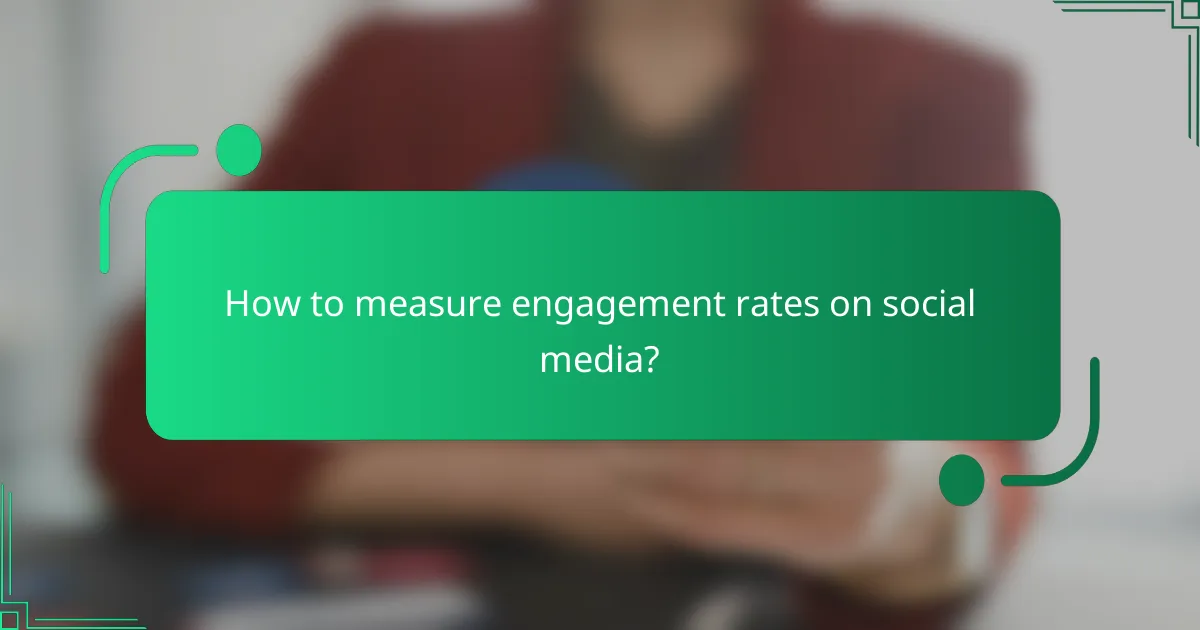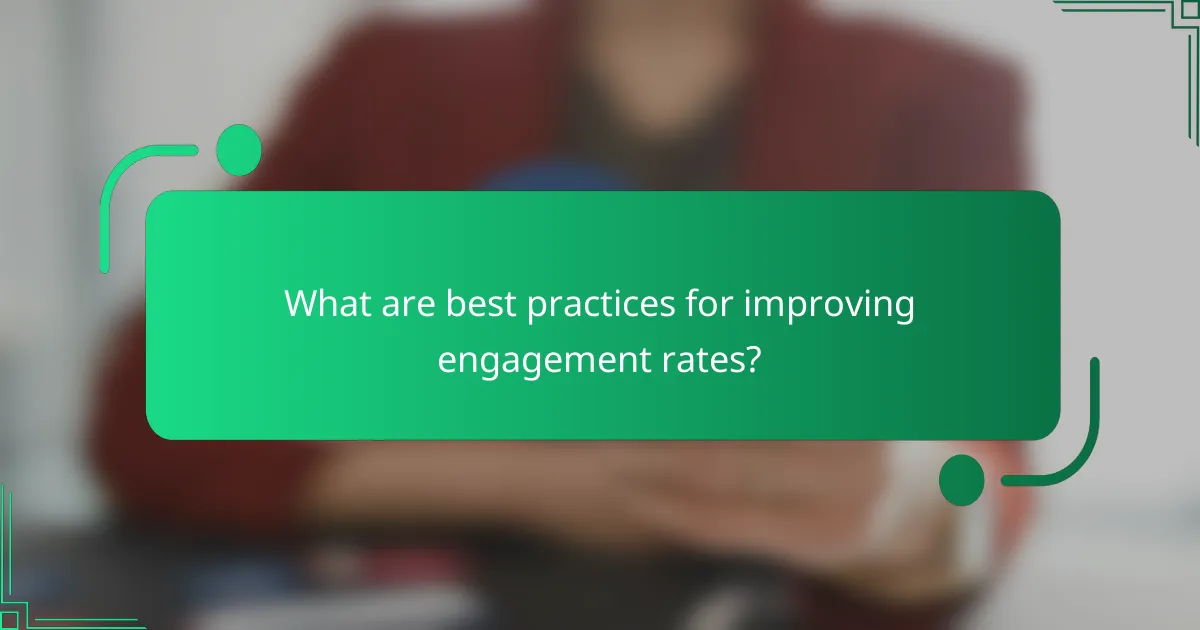Understanding social media metrics such as engagement rates, reach, and conversion tracking is essential for optimizing your online presence. Engagement rates reveal how effectively your content resonates with users, while reach indicates the number of unique individuals exposed to your posts. Additionally, tracking conversions allows you to measure the tangible outcomes of your social media efforts, helping to refine your strategies for better results.

How to measure engagement rates on social media?
Measuring engagement rates on social media involves calculating the level of interaction users have with your content. This metric is crucial for understanding how well your posts resonate with your audience, guiding your content strategy effectively.
Engagement rate formula
The engagement rate is typically calculated using the formula: (Total Engagements / Total Impressions) x 100. Total engagements include likes, comments, shares, and saves, while total impressions refer to how many times your content was displayed.
For example, if a post receives 200 engagements and has 1,000 impressions, the engagement rate would be 20%. This percentage helps you gauge the effectiveness of your content across different platforms.
Tools for tracking engagement
Several tools can help you track engagement rates on social media. Popular options include Hootsuite, Sprout Social, and Buffer, which provide analytics dashboards to monitor your performance over time.
When selecting a tool, consider features like real-time tracking, customizable reports, and integration with multiple social platforms. This will allow you to analyze engagement trends and adjust your strategy accordingly.

What is the importance of reach in social media marketing?
Reach is crucial in social media marketing as it measures the total number of unique users who see your content. A higher reach indicates broader visibility, which can lead to increased brand awareness and potential customer engagement.
Definition of reach
Reach refers to the total number of individuals who have come across your content on social media platforms. It is a key metric that helps marketers understand how far their message is spreading across their target audience.
There are two main types of reach: organic reach, which occurs when users see your content without paid promotion, and paid reach, which is achieved through advertisements. Both types are essential for evaluating the effectiveness of a social media strategy.
Impact of reach on brand visibility
Higher reach directly correlates with increased brand visibility, allowing more potential customers to discover your products or services. When your content reaches a larger audience, it enhances the likelihood of engagement, such as likes, shares, and comments.
To maximize reach, consider using targeted advertising and engaging content that encourages sharing. Regularly analyze your reach metrics to identify which posts perform best and adjust your strategy accordingly. Avoid over-reliance on paid reach, as organic engagement can build a more authentic connection with your audience.

How to track conversions from social media campaigns?
Tracking conversions from social media campaigns involves measuring specific actions users take after interacting with your content, such as purchases or sign-ups. By utilizing various tools and setting clear goals, you can effectively assess the impact of your social media efforts.
Conversion tracking tools
There are several tools available to help track conversions from social media campaigns. Popular options include Google Analytics, Facebook Pixel, and LinkedIn Insight Tag. These tools allow you to monitor user behavior and attribute conversions to specific social media interactions.
When selecting a conversion tracking tool, consider factors such as ease of integration, compatibility with your existing platforms, and the specific metrics you want to analyze. For example, Google Analytics offers comprehensive tracking capabilities, while Facebook Pixel is tailored for Facebook and Instagram campaigns.
Setting up conversion goals
To effectively track conversions, you need to set up clear conversion goals within your chosen tracking tool. These goals could include actions such as completing a purchase, signing up for a newsletter, or downloading a resource. Defining these goals helps you measure the success of your campaigns accurately.
When establishing conversion goals, ensure they align with your overall marketing objectives. Use the SMART criteria—Specific, Measurable, Achievable, Relevant, Time-bound—to create effective goals. For instance, instead of a vague goal like “increase sales,” specify “increase online sales by 20% in the next quarter.” This clarity will help you evaluate your social media campaign’s performance more effectively.

What are best practices for improving engagement rates?
Improving engagement rates involves creating compelling content, posting at optimal times, and maintaining consistency. By focusing on these areas, brands can foster stronger connections with their audience and enhance overall interaction.
Content optimization strategies
To boost engagement, prioritize high-quality, relevant content that resonates with your audience. Use visuals, such as images and videos, to make posts more appealing, as these formats typically garner higher interaction rates.
Incorporate interactive elements like polls, quizzes, and questions to encourage audience participation. Tailor your messaging to reflect current trends and audience interests, which can significantly enhance engagement.
Timing and frequency of posts
Finding the right timing for posts is crucial. Analyze your audience’s online behavior to identify peak activity times, which can vary by platform and demographic. Generally, posting during weekdays, especially mid-morning to early afternoon, tends to yield better results.
Consistency is key; aim to post regularly without overwhelming your audience. A frequency of three to five times a week is often effective, but adjust based on audience feedback and engagement metrics to find the optimal balance.

How does reach affect advertising performance?
Reach significantly impacts advertising performance by determining how many potential customers see your ads. A broader reach can lead to increased brand awareness and higher engagement rates, ultimately influencing conversion rates.
Correlation between reach and ad effectiveness
There is a strong correlation between reach and ad effectiveness, as a larger audience typically results in more interactions and potential sales. Advertisements that reach a wider demographic can generate more impressions, which can translate into higher click-through rates (CTR) and conversions.
However, it’s essential to balance reach with targeting. A campaign that reaches many but engages few may not yield the desired return on investment (ROI). Focusing on the right audience while maximizing reach can enhance overall ad performance.
Case studies of successful campaigns
One notable example is a beverage brand that launched a social media campaign targeting young adults. By utilizing influencers and engaging content, they achieved a reach of millions, resulting in a 30% increase in sales over three months. This demonstrates how effective reach can amplify brand messaging.
Another case involved a local restaurant that used targeted Facebook ads to promote a new menu. By focusing on nearby residents, they achieved a reach of thousands within their community, leading to a significant uptick in foot traffic and reservations. This highlights the importance of combining reach with precise targeting for optimal results.

What metrics should be included in a social media report?
A comprehensive social media report should include metrics such as engagement rates, reach, and conversion tracking. These metrics provide insights into how well content is performing and how it contributes to overall business goals.
Key performance indicators (KPIs)
Key performance indicators (KPIs) are essential metrics that help evaluate the success of social media efforts. Common KPIs include engagement rate, which measures interactions like likes, shares, and comments relative to total followers, and reach, which indicates how many unique users have seen your content.
When selecting KPIs, consider your specific goals. For example, if brand awareness is a priority, focus on reach and impressions. If driving sales is the goal, prioritize conversion rates and click-through rates.
Reporting tools for social media metrics
Various reporting tools can simplify the process of tracking social media metrics. Tools like Google Analytics, Hootsuite, and Sprout Social provide comprehensive dashboards that aggregate data from multiple platforms, making it easier to analyze performance.
When choosing a reporting tool, look for features that align with your needs, such as customizable reports, real-time data tracking, and integration with other marketing tools. Free options may suffice for small businesses, while larger organizations might benefit from more advanced, paid solutions.

What frameworks can help analyze social media metrics?
Frameworks for analyzing social media metrics provide structured approaches to evaluate engagement rates, reach, and conversion tracking. Utilizing these frameworks can help identify strengths and weaknesses in social media strategies, enabling more effective decision-making.
SWOT analysis for social media performance
A SWOT analysis examines the strengths, weaknesses, opportunities, and threats related to social media performance. This framework helps businesses understand their current position by identifying what they do well, where they can improve, potential growth areas, and external challenges.
For instance, a strength might be a high engagement rate on Instagram, while a weakness could be low reach on Facebook. Opportunities may include emerging platforms or trends, while threats could involve increased competition or changing algorithms.
To conduct a SWOT analysis, gather data on your social media metrics and compare them against industry standards. This will provide a clearer picture of where your social media efforts stand.
Benchmarking against competitors
Benchmarking against competitors involves comparing your social media metrics with those of similar businesses. This practice helps identify performance gaps and areas for improvement, ensuring your strategies remain competitive.
Start by selecting key competitors and analyzing their engagement rates, reach, and conversion metrics. Tools like social media analytics platforms can provide insights into their performance, allowing you to set realistic benchmarks for your own efforts.
When benchmarking, focus on relevant metrics that align with your business goals. For example, if your aim is to increase brand awareness, compare reach and impressions. Regularly revisiting these benchmarks can help you adapt your strategy as the social media landscape evolves.

What are emerging trends in social media metrics?
Emerging trends in social media metrics focus on enhancing the understanding of user engagement, reach, and conversion rates through innovative technologies and integrations. Key developments include the use of AI-driven analytics tools and the seamless integration of social media with e-commerce platforms, both of which are reshaping how businesses measure success online.
AI-driven analytics tools
AI-driven analytics tools are transforming the way businesses interpret social media metrics by providing deeper insights into user behavior and engagement patterns. These tools leverage machine learning algorithms to analyze vast amounts of data, allowing for real-time tracking of engagement rates and audience sentiment.
When selecting an AI tool, consider features like predictive analytics, automated reporting, and customizable dashboards. Popular options include Sprout Social and Hootsuite Insights, which can help businesses identify trends and optimize their content strategies effectively.
Integration of social media with e-commerce platforms
The integration of social media with e-commerce platforms is becoming increasingly important for driving conversions. This trend allows businesses to create shoppable posts, enabling users to purchase products directly through social media channels, thus streamlining the customer journey.
Platforms like Instagram and Facebook have introduced features that facilitate this integration, such as Instagram Shopping and Facebook Shops. Businesses should ensure they optimize their social media profiles for e-commerce by using high-quality visuals and clear calls to action, which can significantly enhance conversion rates.